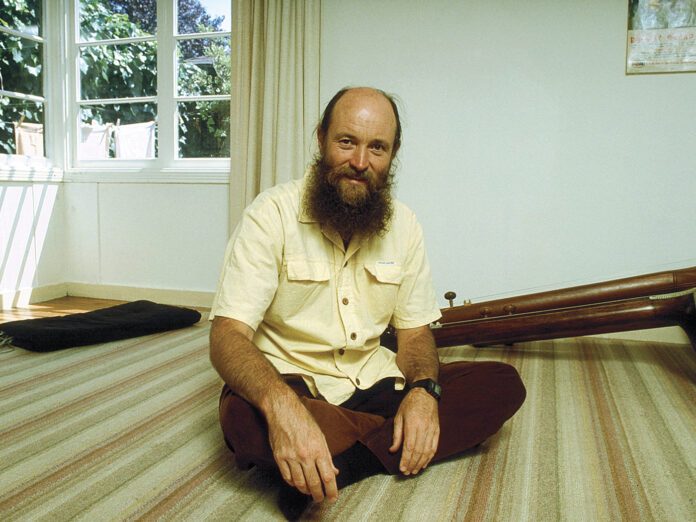For a while there, across the late 1960s and the decade of the 1970s, Terry Riley became the friendly face of contemporary minimal composition. There he was, grinning amiably, superimposed over trees and sky on the cover of his best-known album, 1969’s A Rainbow In Curved Air, a countercultural goofball maverick with chops to spare, his music both spiraling in its hypnotic power, and remarkably easy to get on with. He crops up again in all kinds of contexts – an album with the Velvet Underground’s John Cale, who he also replaced in La Monte Young and Marian Zazeela’s ’60s drone-dream collective, the Theatre of Eternal Music; collaborations with free jazz legend Don Cherry; an inspiration for The Who’s “Baba O’Riley”; myriad versions of his masterpiece of cellular composition, In C.
For a while there, across the late 1960s and the decade of the 1970s, Terry Riley became the friendly face of contemporary minimal composition. There he was, grinning amiably, superimposed over trees and sky on the cover of his best-known album, 1969’s A Rainbow In Curved Air, a countercultural goofball maverick with chops to spare, his music both spiraling in its hypnotic power, and remarkably easy to get on with. He crops up again in all kinds of contexts – an album with the Velvet Underground’s John Cale, who he also replaced in La Monte Young and Marian Zazeela’s ’60s drone-dream collective, the Theatre of Eternal Music; collaborations with free jazz legend Don Cherry; an inspiration for The Who’s “Baba O’Riley”; myriad versions of his masterpiece of cellular composition, In C.
While contemporaries like Philip Glass and Steve Reich became more conservative as the years passed (Glass’s work started to echo the likes of Bartok), and Riley’s one-time colleague La Monte Young devoted his time to willed semi-obscurity, a relative disappearance in line with Young’s demands for cultural and financial recognition, Riley seemed to simply, well, get on with it. Perhaps the ace in his hand was his preternatural capacity for the little cells of melody that bob to the surface in most of his music; it’s charming stuff on the surface, as this first vinyl reissue of 1980’s Shri Camel makes plain, but with much depth, both musical and extra-musical.
Shri Camel summed up a body of work and a process of exploration for Riley. He began composing it in 1975 for Radio Bremen in West Germany and performed an early version of it there; the version documented on this album was recorded in 1978 in San Francisco, though it didn’t see release for several years. It was also his final album for the CBS Masterworks series, which chimes with a general decrease of interest in minimalism from major labels at around this point; artistically valid and gorgeous to listen to, the stuff just didn’t sell particularly well. It’s possible that Riley’s alignment with the stoned-out-of-our-gourds hippie consciousness of the late 1960s counterculture meant he was out of vogue at the time, too.
It all seems rather unfair, looking back, particularly given the rigour with which Riley approached his music. These weren’t the minimalist meanderings of a wasted chancer; Riley was a deeply in tune, widely studied composer-artist whose embrace of approaches like just intonation, the tuning of musical intervals such that they are ‘pure’, and not ‘equal temperament’ like Western tuning, meant the end result of his fiercely intelligent compositions was a cyclical, dizzying hall-of-mirrors where everything seemed to shiver and vibrate just outside of everyday consciousness. That hall-of-mirrors effect was amplified by Riley’s use of delay systems – for Shri Camel, he used a Yamaha organ modified with digital delay and tuned to just intonation.
That digital delay gifts Shri Camel its glissing slip-and-slide and its strange sense of sharp, attenuated dreaminess. You can hear it pretty much immediately, when the thin, reedy drone that underpins “Anthem Of The Trinity” has glittering arpeggios dancing across its wafer-like landscape, with Riley playing both his own melodies and patterns, and the various registers of the organ, off each other. If the drone is the bedrock of the composition, Riley’s organ playing, his extemporisations around a number of themes, gives Shri Camel not just its near-haptic sensuousness, but also its spirit of ascension, as though Riley’s pushing the listener through and beyond the clouds.
After all, Shri Camel is, in some ways, devotional music. By the time of its composition, Riley had already spent a number of years as a formal disciple of the Indian classical singer, Pandit Pran Nath, who trained and performed in the Hindustani ‘Kirana Gharana’ music apprenticeship tradition, a particularly rich and lyrical style: Pran Nath’s was an especially pared-back, slow, ascetic take on this tradition, which can be heard in the paced movements of some of Riley’s compositions, and the work of Young and Zazeela, as well. Riley’s fondness for Nath was simply expressed: he called Nath “the greatest musician I have ever heard.”
It is, perhaps, Nath’s precision that is so important to the music Riley makes on albums like Shri Camel. Even though there are playful moments on this album – the luxuriant, blissful trilling of “Celestial Valley”, for example, where the organ-and-delay sound both like pattering rain and a storm of hail, somehow at the same time – there’s an attention to detail here, particularly to the detail of tone, that’s clearly drawn from Riley’s lessons with Nath, and broader still, his knowledge and embrace of Indian classical music. Shri Camel emerges from a period in Riley’s life where he was deeply invested in the Indian classical tradition, turning his attention to just intonation and the deceptive simplicity of delay and repetition to make music that has a rich, resonant core, a sense of deep play, and a bravura mash of minimalism and improvisation.
When you purchase through links on our site, we may earn an affiliate commission. Here’s how it works.


